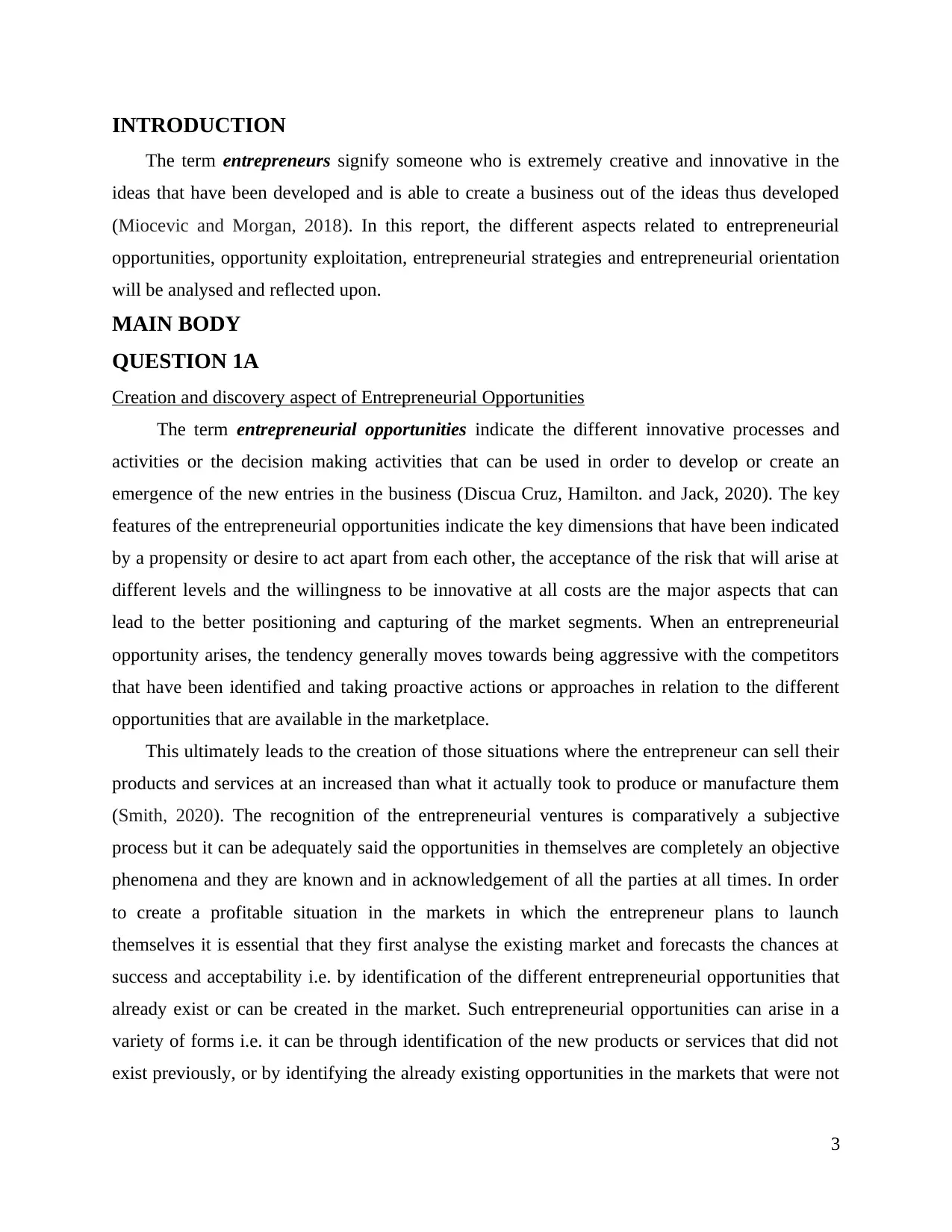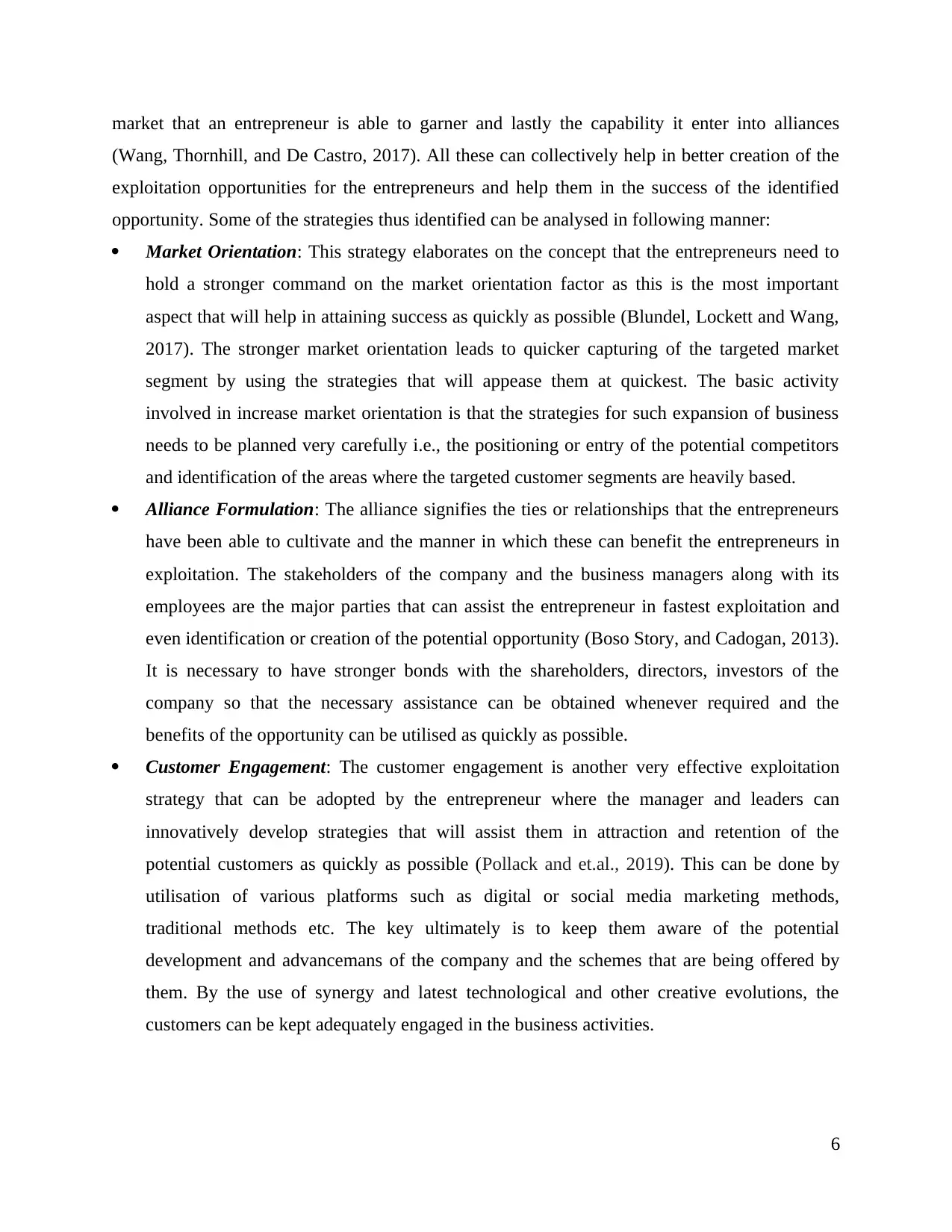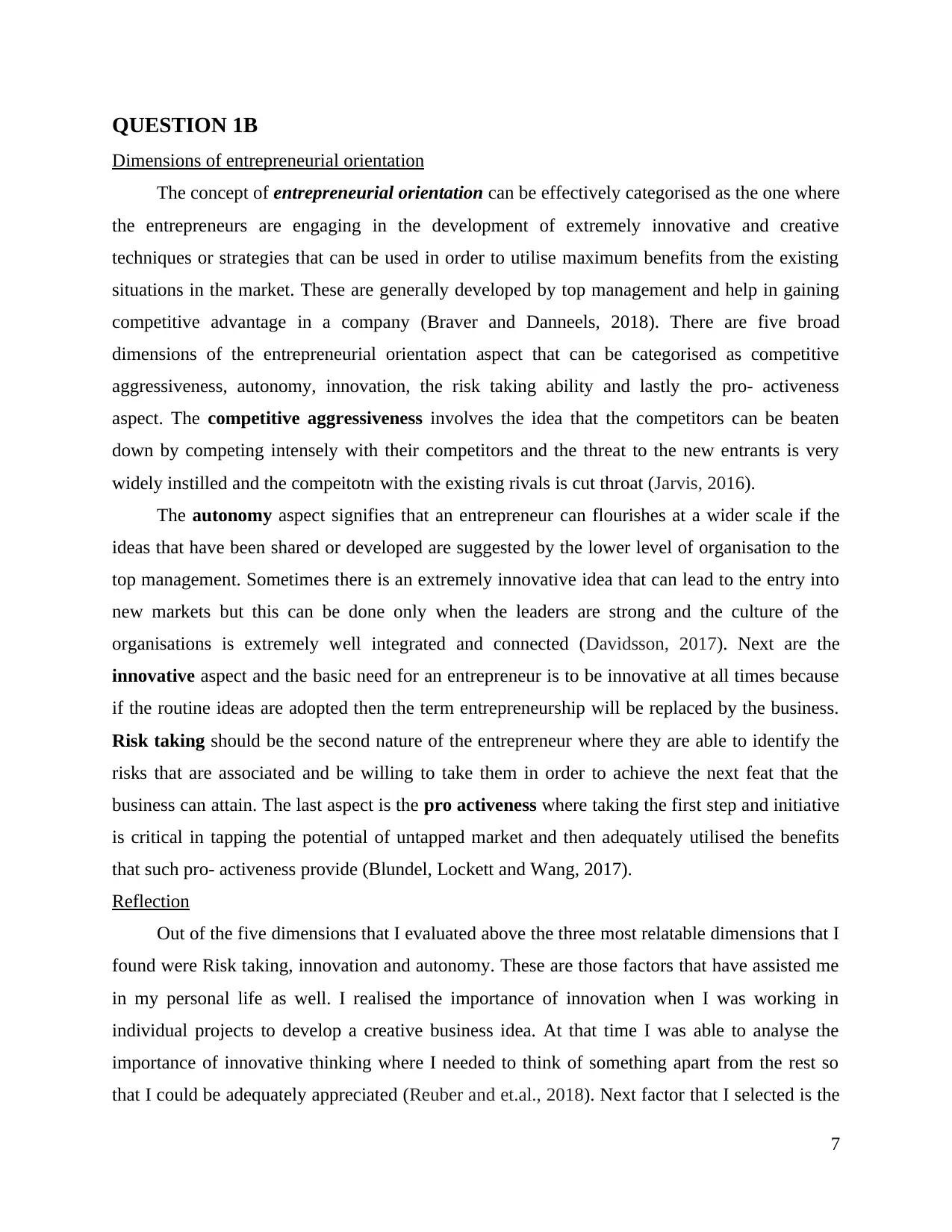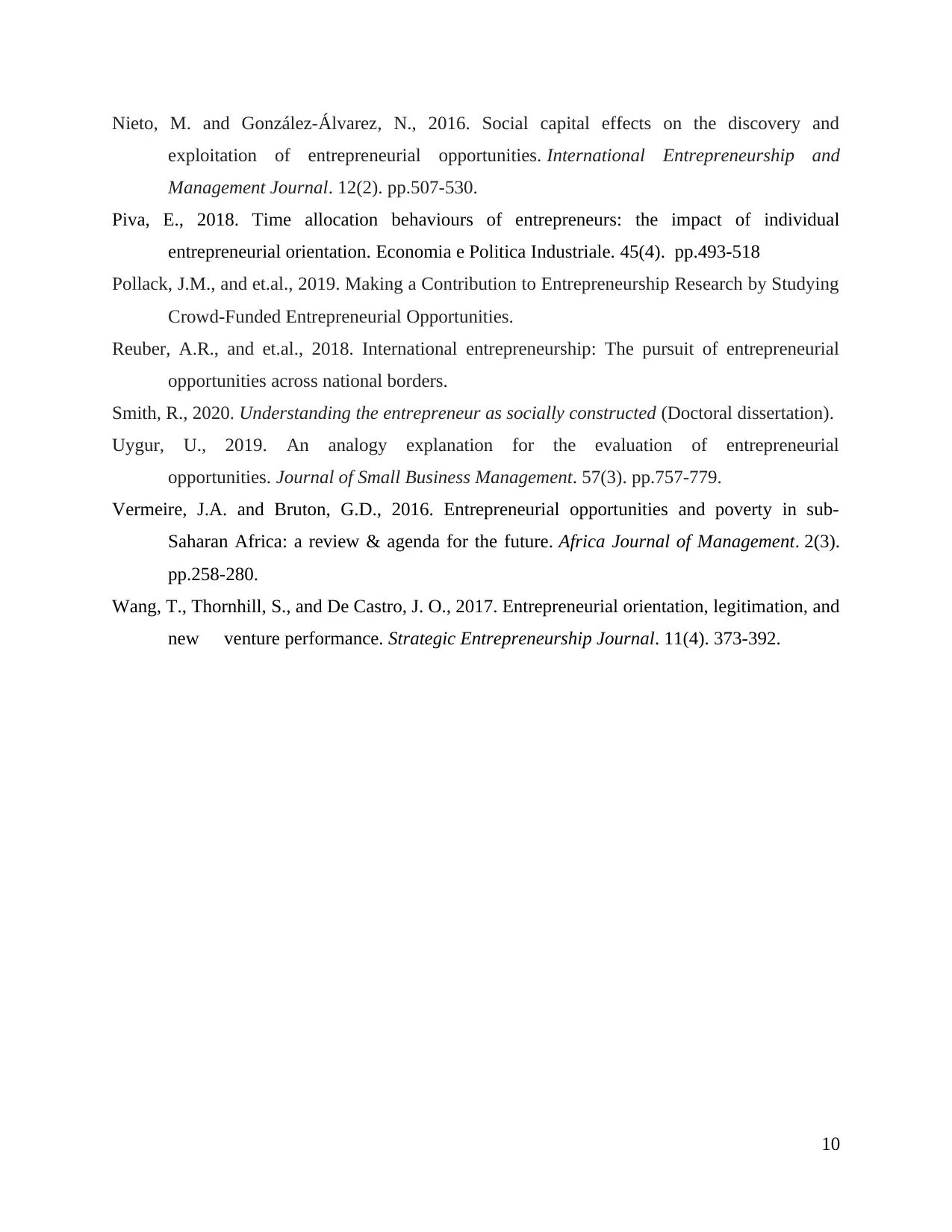Entrepreneurship Theory and Practice: Opportunity and Strategy Report
VerifiedAdded on 2023/01/11
|11
|3040
|47
Report
AI Summary
This report delves into the core concepts of entrepreneurship, exploring the creation and discovery of entrepreneurial opportunities. It analyzes the key dimensions of these opportunities and how they can be effectively exploited through various firm-level capabilities and strategies. The report differentiates between opportunity creation, driven by innovation, and opportunity discovery, which capitalizes on existing market gaps. It also examines entrepreneurial strategies, including market orientation, alliance formulation, and customer engagement. Furthermore, the report discusses the dimensions of entrepreneurial orientation, such as competitive aggressiveness, autonomy, innovation, risk-taking, and pro-activeness. The author reflects on the relevance of these dimensions, emphasizing risk-taking, innovation, and autonomy as personally relatable aspects. This analysis provides valuable insights into the dynamics of entrepreneurship and the strategic approaches needed for success.

ENTERPRENEURSHIP
THEORY AND PRACTICE
THEORY AND PRACTICE
Paraphrase This Document
Need a fresh take? Get an instant paraphrase of this document with our AI Paraphraser

TABLE OF CONTENTS
INTRODUCTION...........................................................................................................................3
MAIN BODY..................................................................................................................................3
QUESTION 1A...............................................................................................................................3
Creation and discovery aspect of Entrepreneurial Opportunities................................................3
Firm level capabilities or strategies for effective exploitation of opportunities..........................5
QUESTION 1B................................................................................................................................7
Dimensions of entrepreneurial orientation..................................................................................7
Reflection.....................................................................................................................................7
REFERENCES................................................................................................................................9
INTRODUCTION...........................................................................................................................3
MAIN BODY..................................................................................................................................3
QUESTION 1A...............................................................................................................................3
Creation and discovery aspect of Entrepreneurial Opportunities................................................3
Firm level capabilities or strategies for effective exploitation of opportunities..........................5
QUESTION 1B................................................................................................................................7
Dimensions of entrepreneurial orientation..................................................................................7
Reflection.....................................................................................................................................7
REFERENCES................................................................................................................................9

INTRODUCTION
The term entrepreneurs signify someone who is extremely creative and innovative in the
ideas that have been developed and is able to create a business out of the ideas thus developed
(Miocevic and Morgan, 2018). In this report, the different aspects related to entrepreneurial
opportunities, opportunity exploitation, entrepreneurial strategies and entrepreneurial orientation
will be analysed and reflected upon.
MAIN BODY
QUESTION 1A
Creation and discovery aspect of Entrepreneurial Opportunities
The term entrepreneurial opportunities indicate the different innovative processes and
activities or the decision making activities that can be used in order to develop or create an
emergence of the new entries in the business (Discua Cruz, Hamilton. and Jack, 2020). The key
features of the entrepreneurial opportunities indicate the key dimensions that have been indicated
by a propensity or desire to act apart from each other, the acceptance of the risk that will arise at
different levels and the willingness to be innovative at all costs are the major aspects that can
lead to the better positioning and capturing of the market segments. When an entrepreneurial
opportunity arises, the tendency generally moves towards being aggressive with the competitors
that have been identified and taking proactive actions or approaches in relation to the different
opportunities that are available in the marketplace.
This ultimately leads to the creation of those situations where the entrepreneur can sell their
products and services at an increased than what it actually took to produce or manufacture them
(Smith, 2020). The recognition of the entrepreneurial ventures is comparatively a subjective
process but it can be adequately said the opportunities in themselves are completely an objective
phenomena and they are known and in acknowledgement of all the parties at all times. In order
to create a profitable situation in the markets in which the entrepreneur plans to launch
themselves it is essential that they first analyse the existing market and forecasts the chances at
success and acceptability i.e. by identification of the different entrepreneurial opportunities that
already exist or can be created in the market. Such entrepreneurial opportunities can arise in a
variety of forms i.e. it can be through identification of the new products or services that did not
exist previously, or by identifying the already existing opportunities in the markets that were not
3
The term entrepreneurs signify someone who is extremely creative and innovative in the
ideas that have been developed and is able to create a business out of the ideas thus developed
(Miocevic and Morgan, 2018). In this report, the different aspects related to entrepreneurial
opportunities, opportunity exploitation, entrepreneurial strategies and entrepreneurial orientation
will be analysed and reflected upon.
MAIN BODY
QUESTION 1A
Creation and discovery aspect of Entrepreneurial Opportunities
The term entrepreneurial opportunities indicate the different innovative processes and
activities or the decision making activities that can be used in order to develop or create an
emergence of the new entries in the business (Discua Cruz, Hamilton. and Jack, 2020). The key
features of the entrepreneurial opportunities indicate the key dimensions that have been indicated
by a propensity or desire to act apart from each other, the acceptance of the risk that will arise at
different levels and the willingness to be innovative at all costs are the major aspects that can
lead to the better positioning and capturing of the market segments. When an entrepreneurial
opportunity arises, the tendency generally moves towards being aggressive with the competitors
that have been identified and taking proactive actions or approaches in relation to the different
opportunities that are available in the marketplace.
This ultimately leads to the creation of those situations where the entrepreneur can sell their
products and services at an increased than what it actually took to produce or manufacture them
(Smith, 2020). The recognition of the entrepreneurial ventures is comparatively a subjective
process but it can be adequately said the opportunities in themselves are completely an objective
phenomena and they are known and in acknowledgement of all the parties at all times. In order
to create a profitable situation in the markets in which the entrepreneur plans to launch
themselves it is essential that they first analyse the existing market and forecasts the chances at
success and acceptability i.e. by identification of the different entrepreneurial opportunities that
already exist or can be created in the market. Such entrepreneurial opportunities can arise in a
variety of forms i.e. it can be through identification of the new products or services that did not
exist previously, or by identifying the already existing opportunities in the markets that were not
3
⊘ This is a preview!⊘
Do you want full access?
Subscribe today to unlock all pages.

Trusted by 1+ million students worldwide

acknowledged previously etc. (Masango and Lassalle, 2020). These can be broadly discussed
through two major aspects i.e. Opportunity creation and opportunity discovery:
Opportunity Creation: The term opportunity creation indicates that the innovative ideas that
have been developed are on the basis of the creation or development by the entrepreneur
themselves. The creation process is more oriented towards the manner in which the existing
needs and demands are perceived and view that has been developed regarding the
opportunities thus identified (Piva, 2018). Creation does not involve active search of any
pre- existing ideas as they have not been already created anywhere in the market i.e. they do
not exist. The opportunities are identified on the basis of actions and response of the people
in the market thus being created or manufactured rather than being discovered.
Opportunity Discovery: Opportunity discovery on the other hand is a more subtle where the
opportunity already exists but it just needs to be identified. Under this type of opportunity, it
is believed that the opportunities are already out there but they have to be discovered or
identified and then developed in such a manner that they can address those unmet needs or
desires (Nieto and González-Álvarez, 2016). This is possible only when the entrepreneur is
able to develop a foresight and can keenly work towards the analysis of different paradigms
and work fields that already exist so that the score of new and relative opportunities can be
identified and analysed adequately.
Differences between opportunity discovery and opportunity creation:
Opportunity Discovery Opportunity Creation
The major difference is that in
opportunity discovery the
opportunities already exist and they
are just waiting to be discovered by
the entrepreneurs independently. This
is generally in regards with the realist
philosophy related to entrepreneurship
(König, Gudd and Baltes, 2017).
Under this type of approach the nature of
the entrepreneurs is different from
those of non entrepreneurs and the
Opportunity creation involves those
Opportunities that do not already exist
and the entrepreneurs need to create it
themselves. Here the identification of
such opportunities is dependent on the
entrepreneurs. Additionally the
philosophy involved is evolutionary
realist philosophy for such
opportunities.
Further, under this the nature of the
entrepreneurs can or cannot differ
4
through two major aspects i.e. Opportunity creation and opportunity discovery:
Opportunity Creation: The term opportunity creation indicates that the innovative ideas that
have been developed are on the basis of the creation or development by the entrepreneur
themselves. The creation process is more oriented towards the manner in which the existing
needs and demands are perceived and view that has been developed regarding the
opportunities thus identified (Piva, 2018). Creation does not involve active search of any
pre- existing ideas as they have not been already created anywhere in the market i.e. they do
not exist. The opportunities are identified on the basis of actions and response of the people
in the market thus being created or manufactured rather than being discovered.
Opportunity Discovery: Opportunity discovery on the other hand is a more subtle where the
opportunity already exists but it just needs to be identified. Under this type of opportunity, it
is believed that the opportunities are already out there but they have to be discovered or
identified and then developed in such a manner that they can address those unmet needs or
desires (Nieto and González-Álvarez, 2016). This is possible only when the entrepreneur is
able to develop a foresight and can keenly work towards the analysis of different paradigms
and work fields that already exist so that the score of new and relative opportunities can be
identified and analysed adequately.
Differences between opportunity discovery and opportunity creation:
Opportunity Discovery Opportunity Creation
The major difference is that in
opportunity discovery the
opportunities already exist and they
are just waiting to be discovered by
the entrepreneurs independently. This
is generally in regards with the realist
philosophy related to entrepreneurship
(König, Gudd and Baltes, 2017).
Under this type of approach the nature of
the entrepreneurs is different from
those of non entrepreneurs and the
Opportunity creation involves those
Opportunities that do not already exist
and the entrepreneurs need to create it
themselves. Here the identification of
such opportunities is dependent on the
entrepreneurs. Additionally the
philosophy involved is evolutionary
realist philosophy for such
opportunities.
Further, under this the nature of the
entrepreneurs can or cannot differ
4
Paraphrase This Document
Need a fresh take? Get an instant paraphrase of this document with our AI Paraphraser

decision making involved is very risky
from the viability or success point of
view.
from that of non entrepreneurs and the
decision making involved is uncertain
rather than risky (Gümüsay, 2018).
Similarities between the opportunity discovery and opportunity creation aspect:
Despite the several differences that have been identified and evaluated between both the
aspects, there are certain similarities as well that exists between both of them (Boso, Story and
Cadogan, 2013). The first major aspect is that these can be developed only by an entrepreneur
who is adequately foresighted and is able to identify the innovative streak will be able to identify
the opportunity that can be utilised irrespective of the fact that is exists or not. The strong passion
to innovate, possession of diverse skills that are required, the entrepreneurial vision and the
various formative actions are the key towards development and identification of the
entrepreneurial opportunities at the correct time.
Firm level capabilities or strategies for effective exploitation of opportunities
The term Opportunity Exploitation can be ascertained as the taking advantage of the
opportunity that has been identified as quickly as possible (Levine and Rubinstein, 2017). This is
done by taking a number of aspects into consideration and it can be adequately said that people
who have greater access to the acquisition of the necessary resources and are able to exploit them
much quicker is one aspect (Mrożewski and Kratzer, 2017). Additionally, if an entrepreneur has
the necessary information either form their contacts or social ties, or due to previous
employment, then also the chances of exploitation of the opportunity increases immensely and
the prior experience in the entrepreneurial ventures is the last contributing factors that can enable
an entrepreneur to effectively utilise or exploit the opportunities that have arisen before them.
There are various entrepreneurial strategies that can be adopted by the organizations in
order to engage in the entrepreneurial ventures such as the strategy of acquiring copyrights or
licensing as soon as possible, the acquisition of the customers that are attracted, acquiring
competitors or other potential business partners that can assist in exploitation etc. (Uygur, 2019).
Apart from these, some of the additional aspects that are being included in the entrepreneurial
strategies for exploitation involved the networking abilities that an entrepreneur possesses, the
market orientation of an entrepreneur that currently exists, the legitimacy of the operation of the
existing strategies that can be used by the entrepreneurs, engagement of the customers in the
5
from the viability or success point of
view.
from that of non entrepreneurs and the
decision making involved is uncertain
rather than risky (Gümüsay, 2018).
Similarities between the opportunity discovery and opportunity creation aspect:
Despite the several differences that have been identified and evaluated between both the
aspects, there are certain similarities as well that exists between both of them (Boso, Story and
Cadogan, 2013). The first major aspect is that these can be developed only by an entrepreneur
who is adequately foresighted and is able to identify the innovative streak will be able to identify
the opportunity that can be utilised irrespective of the fact that is exists or not. The strong passion
to innovate, possession of diverse skills that are required, the entrepreneurial vision and the
various formative actions are the key towards development and identification of the
entrepreneurial opportunities at the correct time.
Firm level capabilities or strategies for effective exploitation of opportunities
The term Opportunity Exploitation can be ascertained as the taking advantage of the
opportunity that has been identified as quickly as possible (Levine and Rubinstein, 2017). This is
done by taking a number of aspects into consideration and it can be adequately said that people
who have greater access to the acquisition of the necessary resources and are able to exploit them
much quicker is one aspect (Mrożewski and Kratzer, 2017). Additionally, if an entrepreneur has
the necessary information either form their contacts or social ties, or due to previous
employment, then also the chances of exploitation of the opportunity increases immensely and
the prior experience in the entrepreneurial ventures is the last contributing factors that can enable
an entrepreneur to effectively utilise or exploit the opportunities that have arisen before them.
There are various entrepreneurial strategies that can be adopted by the organizations in
order to engage in the entrepreneurial ventures such as the strategy of acquiring copyrights or
licensing as soon as possible, the acquisition of the customers that are attracted, acquiring
competitors or other potential business partners that can assist in exploitation etc. (Uygur, 2019).
Apart from these, some of the additional aspects that are being included in the entrepreneurial
strategies for exploitation involved the networking abilities that an entrepreneur possesses, the
market orientation of an entrepreneur that currently exists, the legitimacy of the operation of the
existing strategies that can be used by the entrepreneurs, engagement of the customers in the
5

market that an entrepreneur is able to garner and lastly the capability it enter into alliances
(Wang, Thornhill, and De Castro, 2017). All these can collectively help in better creation of the
exploitation opportunities for the entrepreneurs and help them in the success of the identified
opportunity. Some of the strategies thus identified can be analysed in following manner:
Market Orientation: This strategy elaborates on the concept that the entrepreneurs need to
hold a stronger command on the market orientation factor as this is the most important
aspect that will help in attaining success as quickly as possible (Blundel, Lockett and Wang,
2017). The stronger market orientation leads to quicker capturing of the targeted market
segment by using the strategies that will appease them at quickest. The basic activity
involved in increase market orientation is that the strategies for such expansion of business
needs to be planned very carefully i.e., the positioning or entry of the potential competitors
and identification of the areas where the targeted customer segments are heavily based.
Alliance Formulation: The alliance signifies the ties or relationships that the entrepreneurs
have been able to cultivate and the manner in which these can benefit the entrepreneurs in
exploitation. The stakeholders of the company and the business managers along with its
employees are the major parties that can assist the entrepreneur in fastest exploitation and
even identification or creation of the potential opportunity (Boso Story, and Cadogan, 2013).
It is necessary to have stronger bonds with the shareholders, directors, investors of the
company so that the necessary assistance can be obtained whenever required and the
benefits of the opportunity can be utilised as quickly as possible.
Customer Engagement: The customer engagement is another very effective exploitation
strategy that can be adopted by the entrepreneur where the manager and leaders can
innovatively develop strategies that will assist them in attraction and retention of the
potential customers as quickly as possible (Pollack and et.al., 2019). This can be done by
utilisation of various platforms such as digital or social media marketing methods,
traditional methods etc. The key ultimately is to keep them aware of the potential
development and advancemans of the company and the schemes that are being offered by
them. By the use of synergy and latest technological and other creative evolutions, the
customers can be kept adequately engaged in the business activities.
6
(Wang, Thornhill, and De Castro, 2017). All these can collectively help in better creation of the
exploitation opportunities for the entrepreneurs and help them in the success of the identified
opportunity. Some of the strategies thus identified can be analysed in following manner:
Market Orientation: This strategy elaborates on the concept that the entrepreneurs need to
hold a stronger command on the market orientation factor as this is the most important
aspect that will help in attaining success as quickly as possible (Blundel, Lockett and Wang,
2017). The stronger market orientation leads to quicker capturing of the targeted market
segment by using the strategies that will appease them at quickest. The basic activity
involved in increase market orientation is that the strategies for such expansion of business
needs to be planned very carefully i.e., the positioning or entry of the potential competitors
and identification of the areas where the targeted customer segments are heavily based.
Alliance Formulation: The alliance signifies the ties or relationships that the entrepreneurs
have been able to cultivate and the manner in which these can benefit the entrepreneurs in
exploitation. The stakeholders of the company and the business managers along with its
employees are the major parties that can assist the entrepreneur in fastest exploitation and
even identification or creation of the potential opportunity (Boso Story, and Cadogan, 2013).
It is necessary to have stronger bonds with the shareholders, directors, investors of the
company so that the necessary assistance can be obtained whenever required and the
benefits of the opportunity can be utilised as quickly as possible.
Customer Engagement: The customer engagement is another very effective exploitation
strategy that can be adopted by the entrepreneur where the manager and leaders can
innovatively develop strategies that will assist them in attraction and retention of the
potential customers as quickly as possible (Pollack and et.al., 2019). This can be done by
utilisation of various platforms such as digital or social media marketing methods,
traditional methods etc. The key ultimately is to keep them aware of the potential
development and advancemans of the company and the schemes that are being offered by
them. By the use of synergy and latest technological and other creative evolutions, the
customers can be kept adequately engaged in the business activities.
6
⊘ This is a preview!⊘
Do you want full access?
Subscribe today to unlock all pages.

Trusted by 1+ million students worldwide

QUESTION 1B
Dimensions of entrepreneurial orientation
The concept of entrepreneurial orientation can be effectively categorised as the one where
the entrepreneurs are engaging in the development of extremely innovative and creative
techniques or strategies that can be used in order to utilise maximum benefits from the existing
situations in the market. These are generally developed by top management and help in gaining
competitive advantage in a company (Braver and Danneels, 2018). There are five broad
dimensions of the entrepreneurial orientation aspect that can be categorised as competitive
aggressiveness, autonomy, innovation, the risk taking ability and lastly the pro- activeness
aspect. The competitive aggressiveness involves the idea that the competitors can be beaten
down by competing intensely with their competitors and the threat to the new entrants is very
widely instilled and the compeitotn with the existing rivals is cut throat (Jarvis, 2016).
The autonomy aspect signifies that an entrepreneur can flourishes at a wider scale if the
ideas that have been shared or developed are suggested by the lower level of organisation to the
top management. Sometimes there is an extremely innovative idea that can lead to the entry into
new markets but this can be done only when the leaders are strong and the culture of the
organisations is extremely well integrated and connected (Davidsson, 2017). Next are the
innovative aspect and the basic need for an entrepreneur is to be innovative at all times because
if the routine ideas are adopted then the term entrepreneurship will be replaced by the business.
Risk taking should be the second nature of the entrepreneur where they are able to identify the
risks that are associated and be willing to take them in order to achieve the next feat that the
business can attain. The last aspect is the pro activeness where taking the first step and initiative
is critical in tapping the potential of untapped market and then adequately utilised the benefits
that such pro- activeness provide (Blundel, Lockett and Wang, 2017).
Reflection
Out of the five dimensions that I evaluated above the three most relatable dimensions that I
found were Risk taking, innovation and autonomy. These are those factors that have assisted me
in my personal life as well. I realised the importance of innovation when I was working in
individual projects to develop a creative business idea. At that time I was able to analyse the
importance of innovative thinking where I needed to think of something apart from the rest so
that I could be adequately appreciated (Reuber and et.al., 2018). Next factor that I selected is the
7
Dimensions of entrepreneurial orientation
The concept of entrepreneurial orientation can be effectively categorised as the one where
the entrepreneurs are engaging in the development of extremely innovative and creative
techniques or strategies that can be used in order to utilise maximum benefits from the existing
situations in the market. These are generally developed by top management and help in gaining
competitive advantage in a company (Braver and Danneels, 2018). There are five broad
dimensions of the entrepreneurial orientation aspect that can be categorised as competitive
aggressiveness, autonomy, innovation, the risk taking ability and lastly the pro- activeness
aspect. The competitive aggressiveness involves the idea that the competitors can be beaten
down by competing intensely with their competitors and the threat to the new entrants is very
widely instilled and the compeitotn with the existing rivals is cut throat (Jarvis, 2016).
The autonomy aspect signifies that an entrepreneur can flourishes at a wider scale if the
ideas that have been shared or developed are suggested by the lower level of organisation to the
top management. Sometimes there is an extremely innovative idea that can lead to the entry into
new markets but this can be done only when the leaders are strong and the culture of the
organisations is extremely well integrated and connected (Davidsson, 2017). Next are the
innovative aspect and the basic need for an entrepreneur is to be innovative at all times because
if the routine ideas are adopted then the term entrepreneurship will be replaced by the business.
Risk taking should be the second nature of the entrepreneur where they are able to identify the
risks that are associated and be willing to take them in order to achieve the next feat that the
business can attain. The last aspect is the pro activeness where taking the first step and initiative
is critical in tapping the potential of untapped market and then adequately utilised the benefits
that such pro- activeness provide (Blundel, Lockett and Wang, 2017).
Reflection
Out of the five dimensions that I evaluated above the three most relatable dimensions that I
found were Risk taking, innovation and autonomy. These are those factors that have assisted me
in my personal life as well. I realised the importance of innovation when I was working in
individual projects to develop a creative business idea. At that time I was able to analyse the
importance of innovative thinking where I needed to think of something apart from the rest so
that I could be adequately appreciated (Reuber and et.al., 2018). Next factor that I selected is the
7
Paraphrase This Document
Need a fresh take? Get an instant paraphrase of this document with our AI Paraphraser

autonomy and this was also used by me when we were working in a team project and the whole
class was segregated into different segments all preparing some different part of activity. I was
very confused regarding a certain aspect and then there was a suggestion that was made by a
very shy team member to me that immediately helped in identifying the solution to the problem
that we were facing this made me realise that how important autonomy in innovation and
creativity is (Vermeire and Bruton, 2016). Salty, the risk taking aspect was used by me all
throughout the major decisions that I took for my life such as the decision to quit the sports club
in the school of which I was the leader and then joining the drama club that was not considered
as very cool and highly stupid at that time. But I knew that I would excel much more in that club
and this I did but had I not taken that risk than I would not have been able to achieve those
accomplishments.
8
class was segregated into different segments all preparing some different part of activity. I was
very confused regarding a certain aspect and then there was a suggestion that was made by a
very shy team member to me that immediately helped in identifying the solution to the problem
that we were facing this made me realise that how important autonomy in innovation and
creativity is (Vermeire and Bruton, 2016). Salty, the risk taking aspect was used by me all
throughout the major decisions that I took for my life such as the decision to quit the sports club
in the school of which I was the leader and then joining the drama club that was not considered
as very cool and highly stupid at that time. But I knew that I would excel much more in that club
and this I did but had I not taken that risk than I would not have been able to achieve those
accomplishments.
8

REFERENCES
Books and Journals
Blundel, R., Lockett, N., and Wang, C., 2017. Exploring entrepreneurship. Sage.chapter 6
Boso, N., Story, V. M., and Cadogan, J. W., 2013. Entrepreneurial orientation, market
orientation, network ties, and performance: Study of entrepreneurial firms in a
developing economy. Journal of Business Venturing. 28(6). 708-727
Braver, L. and Danneels, E., 2018. Propensities return us to the discovery-creation debate about
entrepreneurial opportunities. Academy of Management Review. 43(4). pp.812-815.
Davidsson, P., 2017. Entrepreneurial opportunities as propensities: Do Ramoglou & Tsang move
the field forward?. Journal of Business Venturing Insights. 7. pp.82-85.
Discua Cruz, A., Hamilton, E. and Jack, S.L., 2020. Understanding entrepreneurial opportunities
through metaphors: a narrative approach to theorizing family entrepreneurship.
Entrepreneurship & Regional Development, pp.1-22.
Gümüsay, A.A., 2018. Unpacking entrepreneurial opportunities: an institutional logics
perspective. Innovation. 20(3). pp.209-222.
Jarvis, L.C., 2016. Identification, intentions and entrepreneurial opportunities: an integrative
process model. international Journal of entrepreneurial Behavior & Research.
König, M., Gudd, G., and Baltes, G., 2017, June. Business model validity in early-stage
technology ventures' business plans testing agreement between text and reality. In 2017
International Conference on Engineering, Technology and Innovation (ICE/ITMC) (pp.
930-937). IEEE.
Levine, R. and Rubinstein, Y., 2017. Smart and illicit: who becomes an entrepreneur and do they
earn more?. The Quarterly Journal of Economics. 132(2). pp.963-1018.
Masango, S. and Lassalle, P., 2020. What entrepreneurs do? Entrepreneurial action guided by
entrepreneurial opportunities and entrepreneurial learning in early internationalising
firms. International Marketing Review.
Miocevic, D. and Morgan, R.E., 2018. Operational capabilities and entrepreneurial opportunities
in emerging market firms. International Marketing Review.
Mrożewski, M. and Kratzer, J., 2017. Entrepreneurship and country-level innovation:
Investigating the role of entrepreneurial opportunities. The Journal of Technology
Transfer. 42(5). pp.1125-1142.
9
Books and Journals
Blundel, R., Lockett, N., and Wang, C., 2017. Exploring entrepreneurship. Sage.chapter 6
Boso, N., Story, V. M., and Cadogan, J. W., 2013. Entrepreneurial orientation, market
orientation, network ties, and performance: Study of entrepreneurial firms in a
developing economy. Journal of Business Venturing. 28(6). 708-727
Braver, L. and Danneels, E., 2018. Propensities return us to the discovery-creation debate about
entrepreneurial opportunities. Academy of Management Review. 43(4). pp.812-815.
Davidsson, P., 2017. Entrepreneurial opportunities as propensities: Do Ramoglou & Tsang move
the field forward?. Journal of Business Venturing Insights. 7. pp.82-85.
Discua Cruz, A., Hamilton, E. and Jack, S.L., 2020. Understanding entrepreneurial opportunities
through metaphors: a narrative approach to theorizing family entrepreneurship.
Entrepreneurship & Regional Development, pp.1-22.
Gümüsay, A.A., 2018. Unpacking entrepreneurial opportunities: an institutional logics
perspective. Innovation. 20(3). pp.209-222.
Jarvis, L.C., 2016. Identification, intentions and entrepreneurial opportunities: an integrative
process model. international Journal of entrepreneurial Behavior & Research.
König, M., Gudd, G., and Baltes, G., 2017, June. Business model validity in early-stage
technology ventures' business plans testing agreement between text and reality. In 2017
International Conference on Engineering, Technology and Innovation (ICE/ITMC) (pp.
930-937). IEEE.
Levine, R. and Rubinstein, Y., 2017. Smart and illicit: who becomes an entrepreneur and do they
earn more?. The Quarterly Journal of Economics. 132(2). pp.963-1018.
Masango, S. and Lassalle, P., 2020. What entrepreneurs do? Entrepreneurial action guided by
entrepreneurial opportunities and entrepreneurial learning in early internationalising
firms. International Marketing Review.
Miocevic, D. and Morgan, R.E., 2018. Operational capabilities and entrepreneurial opportunities
in emerging market firms. International Marketing Review.
Mrożewski, M. and Kratzer, J., 2017. Entrepreneurship and country-level innovation:
Investigating the role of entrepreneurial opportunities. The Journal of Technology
Transfer. 42(5). pp.1125-1142.
9
⊘ This is a preview!⊘
Do you want full access?
Subscribe today to unlock all pages.

Trusted by 1+ million students worldwide

Nieto, M. and González-Álvarez, N., 2016. Social capital effects on the discovery and
exploitation of entrepreneurial opportunities. International Entrepreneurship and
Management Journal. 12(2). pp.507-530.
Piva, E., 2018. Time allocation behaviours of entrepreneurs: the impact of individual
entrepreneurial orientation. Economia e Politica Industriale. 45(4). pp.493-518
Pollack, J.M., and et.al., 2019. Making a Contribution to Entrepreneurship Research by Studying
Crowd-Funded Entrepreneurial Opportunities.
Reuber, A.R., and et.al., 2018. International entrepreneurship: The pursuit of entrepreneurial
opportunities across national borders.
Smith, R., 2020. Understanding the entrepreneur as socially constructed (Doctoral dissertation).
Uygur, U., 2019. An analogy explanation for the evaluation of entrepreneurial
opportunities. Journal of Small Business Management. 57(3). pp.757-779.
Vermeire, J.A. and Bruton, G.D., 2016. Entrepreneurial opportunities and poverty in sub-
Saharan Africa: a review & agenda for the future. Africa Journal of Management. 2(3).
pp.258-280.
Wang, T., Thornhill, S., and De Castro, J. O., 2017. Entrepreneurial orientation, legitimation, and
new venture performance. Strategic Entrepreneurship Journal. 11(4). 373-392.
10
exploitation of entrepreneurial opportunities. International Entrepreneurship and
Management Journal. 12(2). pp.507-530.
Piva, E., 2018. Time allocation behaviours of entrepreneurs: the impact of individual
entrepreneurial orientation. Economia e Politica Industriale. 45(4). pp.493-518
Pollack, J.M., and et.al., 2019. Making a Contribution to Entrepreneurship Research by Studying
Crowd-Funded Entrepreneurial Opportunities.
Reuber, A.R., and et.al., 2018. International entrepreneurship: The pursuit of entrepreneurial
opportunities across national borders.
Smith, R., 2020. Understanding the entrepreneur as socially constructed (Doctoral dissertation).
Uygur, U., 2019. An analogy explanation for the evaluation of entrepreneurial
opportunities. Journal of Small Business Management. 57(3). pp.757-779.
Vermeire, J.A. and Bruton, G.D., 2016. Entrepreneurial opportunities and poverty in sub-
Saharan Africa: a review & agenda for the future. Africa Journal of Management. 2(3).
pp.258-280.
Wang, T., Thornhill, S., and De Castro, J. O., 2017. Entrepreneurial orientation, legitimation, and
new venture performance. Strategic Entrepreneurship Journal. 11(4). 373-392.
10
Paraphrase This Document
Need a fresh take? Get an instant paraphrase of this document with our AI Paraphraser

11
1 out of 11
Related Documents
Your All-in-One AI-Powered Toolkit for Academic Success.
+13062052269
info@desklib.com
Available 24*7 on WhatsApp / Email
![[object Object]](/_next/static/media/star-bottom.7253800d.svg)
Unlock your academic potential
Copyright © 2020–2025 A2Z Services. All Rights Reserved. Developed and managed by ZUCOL.





